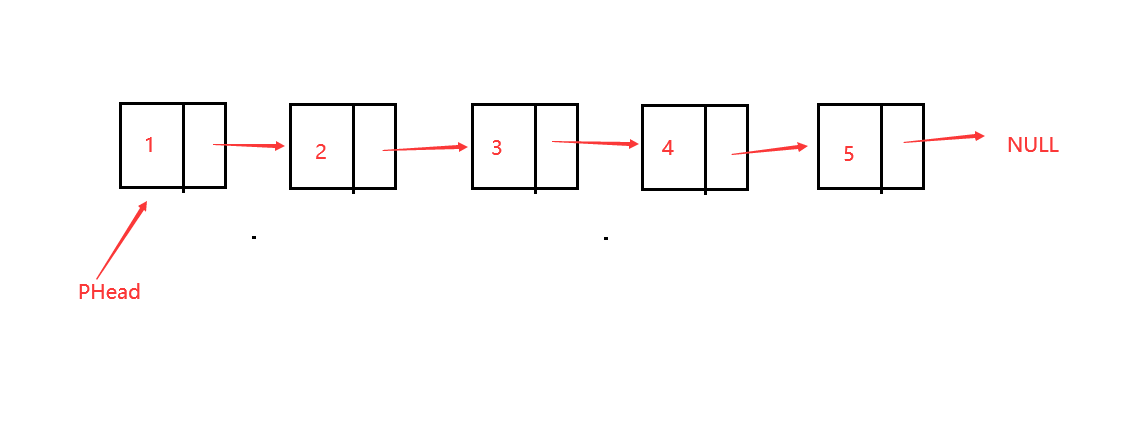C语言链表
链表的概念及结构
概念
链表是一种物理存储结构上非连续、非顺序的存储结构,数据元素的逻辑顺序是通过链表中的指针链接次序实现的 。
结构
- 代码
struct Slist
{
int* a;
struct Slist* next;
};
-
逻辑结构:
-
物理结构:
-
注意:
- 从上图可以看出,链式结构在逻辑上是连续的,但是在物理上是不一定是连续的。
- 这些结点一般是从堆上申请出来的。
- 从堆上申请的空间,是按照一定的策划来分配的,两次申请的空间可能连续,大概率是不连续的。
链表的分类
-
实际中链表的结构非常多样,以下情况组合起来就有8种链表结构:
1. 单向或者双向
①单向
②双向
2.带头或者不带头
①带头
②不带头
3.循环或者非循环
①循环
②非循环 -
虽然有这么多种结构的链表,但是我们实际中最常用的只有两种结构:
1. 无头单向非循环链表2.带头双向循环链表
1. 无头单向非循环链表:结构简单,一般不会单独用来存数据。实际中更多是作为其他数据结构的子结构,如哈希桶、图的邻接表等等。另外这种结构在笔试面试中出现很多。
2. 带头双向循环链表:结构最复杂,一般用在单独存储数据。实际中使用的链表数据结构,都是带头双向循环链表。另外这个结构虽然结构复杂,但是使用代码实现以后会发现结构会带来很多优势,实现反而简单了,后面我们代码实现了就知道了。
单链表的实现(无头)
- 单链表结构
typedef int SLTDateType;
typedef struct SListNode
{
SLTDateType data;
struct SListNode* next;
}SListNode;
- 单链表需要的功能
// 动态申请一个节点
SListNode* BuySListNode(SLTDateType x);
// 单链表打印
void SListPrint(SListNode* plist);
// 单链表尾插
void SListPushBack(SListNode** pplist, SLTDateType x);
// 单链表的头插
void SListPushFront(SListNode** pplist, SLTDateType x);
// 单链表的尾删
void SListPopBack(SListNode** pplist);
// 单链表头删
void SListPopFront(SListNode** pplist);
// 单链表查找
SListNode* SListFind(SListNode* plist, SLTDateType x);
// 单链表在pos位置之后插入x
// 分析思考为什么不在pos位置之前插入?
void SListInsertAfter(SListNode* pos, SLTDateType x);
// 单链表删除pos位置之后的值
// 分析思考为什么不删除pos位置?
void SListEraseAfter(SListNode* pos);
// 单链表的销毁
void SListDestory(SListNode** pplist);
- 功能实现
SListNode* BuySListNode(SLTDateType x)
{
SListNode* newnode = (SListNode*)malloc(sizeof(SListNode));
if (newnode == NULL)
{
exit(-1);
}
newnode->data = x;
return newnode;
}
void SListPrint(SListNode* plist)
{
if (plist == NULL)
{
printf("NULL\n");
return;
}
else
{
while (plist)
{
printf("%d->", plist->data);
plist = plist->next;
}
printf("NULL\n");
}
}
void SListPushBack(SListNode** pplist, SLTDateType x)
{
SListNode* tail = *pplist;
SListNode* newnode = BuySListNode(x);
newnode->next = NULL;
if (tail == NULL)
{
*pplist = newnode;
}
else
{
while (tail->next)
{
tail = tail->next;
}
tail->next = newnode;
}
}
void SListPushFront(SListNode** pplist, SLTDateType x)
{
SListNode* newnode = BuySListNode(x);
newnode->next = *pplist;
*pplist = newnode;
}
void SListPopBack(SListNode** pplist)
{
assert(*pplist);
SListNode* tail = *pplist;
SListNode* Pretail = NULL;
if (tail->next == NULL)
{
*pplist = NULL;
return;
}
else
{
while (tail->next)
{
Pretail = tail;
tail = tail->next;
}
free(tail);
tail = NULL;
Pretail->next = NULL;
}
}
void SListPopFront(SListNode** pplist)
{
assert(*pplist);
SListNode* front = *pplist;
*pplist = front->next;
free(front);
front = NULL;
}
SListNode* SListFind(SListNode* plist, SLTDateType x)
{
assert(plist);
SListNode* pos = plist;
while (pos && pos->data != x)
{
pos = pos->next;
}
return pos;
}
void SListInsertAfter(SListNode* pos, SLTDateType x)
{
assert(pos);
SListNode* newnode = BuySListNode(x);
newnode->next = pos->next;
pos->next = newnode;
}
void SListEraseAfter(SListNode* pos)
{
assert(pos);
assert(pos->next);
SListNode* node = pos->next;
pos->next = node->next;
free(node);
}
void SListDestory(SListNode** pplist)
{
SListNode* node = *pplist;
SListNode* PreNode = NULL;
while (node)
{
PreNode = node->next;
free(node);
node = PreNode;
}
}
双向链表的实现
- 双向链表的结构
typedef int LTDateType;
typedef struct ListNode
{
LTDateType data;
struct ListNode* next;
struct ListNode* prev;
}LTNode;
- 双向链表的功能
//创建链表返回头结点
LTNode* ListInit();
// 双向链表销毁
void ListDestory(LTNode* phead);
// 双向链表打印
void ListPrint(LTNode* phead);
// 双向链表尾插
void ListPushBack(LTNode* phead, LTDateType x);
// 双向链表尾删
void ListPopBack(LTNode* phead);
// 双向链表头插
void ListPushFront(LTNode* phead, LTDateType x);
// 双向链表头删
void ListPopFront(LTNode* phead);
// 双向链表查找
LTNode* ListFind(LTNode* phead, LTDateType x);
// 双向链表在pos的前面进行插入
void ListInsert(LTNode* pos, LTDateType x);
// 双向链表删除pos位置的节点
void ListErase(LTNode* pos);
- 功能实现
LTNode* ListInit()
{
//哨兵位头结点
LTNode* phead = (LTNode*)malloc(sizeof(LTNode));
if (phead == NULL)
{
printf("开辟空间失败!!!\n");
exit(-1);
}
phead->next = phead;
phead->prev = phead;
return phead;
}
void ListDestory(LTNode* phead)
{
assert(phead);
LTNode* cur = phead;
LTNode* p = NULL;
LTNode* tail = phead->prev;
while (cur != tail)
{
p = cur;
cur = cur->next;
free(p);
}
free(tail);
}
void ListPrint(LTNode* phead)
{
assert(phead);
LTNode* front = phead->next;
while (front != phead)
{
printf("%d ", front->data);
front = front->next;
}
printf("\n");
}
void ListPushBack(LTNode* phead, LTDateType x)
{
assert(phead);
LTNode* tail = phead->prev;
LTNode* newnode = (LTNode*)malloc(sizeof(LTNode));
if (newnode == NULL)
{
printf("开辟空间失败!!\n");
exit(-1);
}
newnode->data = x;
tail->next = newnode;
newnode->prev = tail;
newnode->next = phead;
phead->prev = newnode;
}
void ListPopBack(LTNode* phead)
{
assert(phead);
assert(phead != phead->next);
LTNode* tail = phead->prev;
LTNode* TailFront = tail->prev;
TailFront->next = phead;
phead->prev = TailFront;
free(tail);
}
void ListPushFront(LTNode* phead, LTDateType x)
{
assert(phead);
LTNode* next = phead->next;
LTNode* newnode = (LTNode*)malloc(sizeof(LTNode));
if (newnode == NULL)
{
printf("开辟空间失败!!\n");
exit(-1);
}
newnode->data = x;
phead->next = newnode;
newnode->prev = phead;
newnode->next = next;
next->prev = newnode;
}
void ListPopFront(LTNode* phead)
{
assert(phead);
assert(phead != phead->next);
LTNode* head = phead->next;//头结点
phead->next = head->next;
head->next->prev = phead;
free(head);
}
LTNode* ListFind(LTNode* phead, LTDateType x)
{
assert(phead);
LTNode* cur = phead->next;
while (cur != phead)
{
if (cur->data == x)
{
return cur;
}
cur = cur->next;
}
return NULL;
}
void ListInsert(LTNode* pos, LTDateType x)
{
assert(pos);
LTNode* posPrev = pos->prev;
LTNode* newnode = (LTNode*)malloc(sizeof(LTNode));
if (newnode == NULL)
{
printf("开辟空间失败!!\n");
exit(-1);
}
newnode->data = x;
posPrev->next = newnode;
newnode->prev = posPrev;
newnode->next = pos;
pos->prev = newnode;
}
void ListErase(LTNode* pos)
{
assert(pos);
LTNode* posPrev = pos->prev;
LTNode* posNext = pos->next;
posPrev->next = posNext;
posNext->prev = posPrev;
free(pos);
}
总结:链表和顺序表的区别
| 不同点 | 顺序表 | 链表 |
|---|---|---|
| 存储空间上 | 物理上一定连续 | 逻辑上连续,物理上不一定连续 |
| 随机访问 | 支持 | 不支持 |
| 任意位置上插入或者删除元素 | 可能需要移动元素,效率低下 | 只需修改指针指向 |
| 插入 | 动态顺序表,空间不够时需要扩容 | 没有容量的概念 |
| 应用场景 | 元素高效存储+频繁访问 | 任意位置插入和删除频繁 |
今天的文章C语言链表分享到此就结束了,感谢您的阅读。
版权声明:本文内容由互联网用户自发贡献,该文观点仅代表作者本人。本站仅提供信息存储空间服务,不拥有所有权,不承担相关法律责任。如发现本站有涉嫌侵权/违法违规的内容, 请发送邮件至 举报,一经查实,本站将立刻删除。
如需转载请保留出处:https://bianchenghao.cn/8813.html




 2.带头或者不带头
2.带头或者不带头
 3.循环或者非循环
3.循环或者非循环
